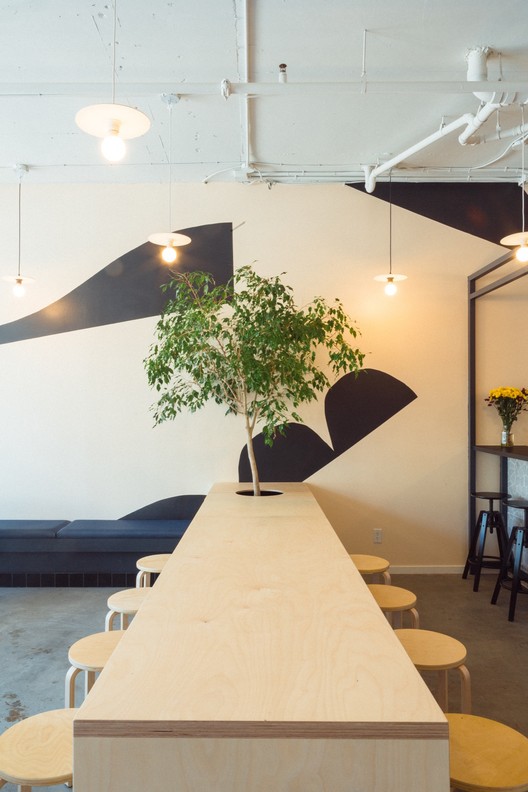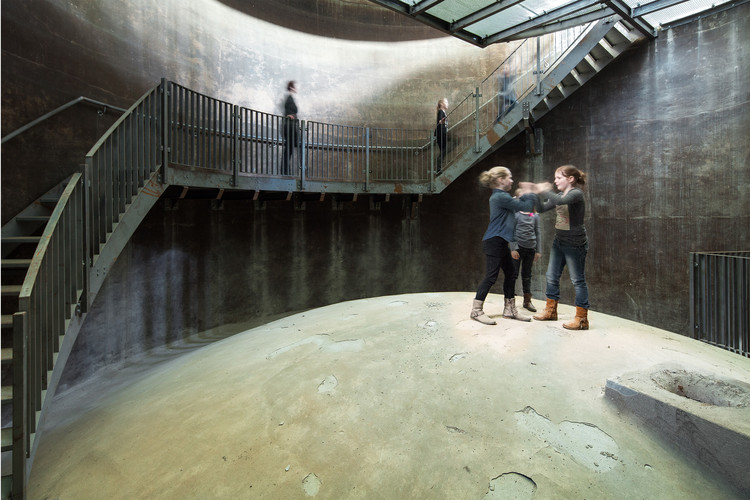Winona House 258 Research + Design
2014-02-19 01:00
架构师提供的文本描述。背景:这栋房子坐落在渥太华河附近的城市街区韦斯特博罗,坐落于20世纪初建造的一座原始村舍的遗址上,当时该地区仍被用来伐木。目前的业主在2009年买下这套房产时,原本打算扩建800平方英尺的二层住宅,但对地基和内部结构进行更仔细的调查发现,最初的结构多年来严重恶化,无法保存。
Text description provided by the architects. Background: Located in Westboro, an urban neighbourhood close to the Ottawa river, the house sits on the site of one of the original cottages built in the early 1900s when the area was still used for logging. When the current owners bought the property in 2009, they originally had the intention of expanding the 800 square foot house with a second storey addition, but a closer investigation of the foundation and interior structure revealed that the initial structure had deteriorated significantly over the years and could not be preserved.
由于物业的理想位置,居民们并没有在另一个社区寻找更大的房子,而是选择拆除现有的建筑,并在工地上建造一座新房子。为了符合严格的分区要求,原有房屋的足迹被保留下来,但内部空间被重新组织,使房屋能够为私人住宅服务,并具有容纳家庭事务的灵活性。
Due to the desirable location of the property, rather than looking for a larger house in another neighbourhood, the residents opted to demolish the existing structure and build a new house on the site. To conform to strict zoning requirements, the footprint of the original house was maintained, but the interior space was re-organized to enable the house to serve a private residence, with the flexibility to accommodate a home business.
聚集:金属包层从许多乡村谷仓中汲取灵感,这些谷仓点缀在城市核心外的景观中。该工业材料是重量轻,耐用和可循环利用。外部的单色选择有助于划定原来的房子的足迹和新的补充。白色聚集的“鬼”,房子的原始轮廓,而黑色的部分突出新的补充,被插入到白色的底部。
Massing: The metal cladding draws inspiration from the many rural barns which dot the landscape just outside the city core. The industrial material is lightweight, durable and recyclable. The exterior's monochromatic color selection helps demarcate the footprint of the original house and the new additions. The white massing 'ghosts' the original outline of the house while the black portions highlight the new additions that are inserted into the white base.
新的二楼加装物被设想为一个漂浮在地面上的“吊舱”。它是独立于房屋底座的回收钢柱。“豆荚”的南部与原来的房子成八度角。悬臂的角度部分与地产线平行运行,并利用房屋的空气权来最大化居住空间,同时符合分区法规。虽然悬臂可以继续深入后院,它削减到房子的后面,以保存两个成熟的雪松位于住宅的后方。
The new second floor addition was conceived as a 'pod' that floats above the ground. It is supported independently from the base of the house by recycled steel columns. The southern portion of the 'pod' tapers out on an eight degree angle from the original house. The angled portion of the cantilever runs parallel to the property line and takes advantage of the air rights of the house to maximize living space while conforming with zoning by-laws. Although the cantilever could continue further into the backyard it cuts back towards the rear of the house in order to preserve two mature cedars located in the rear of the residence.
材料颜色:为了认识到与原始渥太华谷木材贸易的紧密联系,从渥太华河回收的木材中砍下的松木板被用在整个房子的地板上。在地板上使用白色的洗涤剂可以为整个房子提供明亮的光线。明亮和中性的托盘继续与白色的墙壁和橱柜。与白色墙壁形成对比的是房子的“核心”,漆成炭灰色。核心充当垂直穿过住宅中心的视觉锚。
Materials + Color: To recognize the strong ties to the original Ottawa Valley lumber trade, pine boards cut from reclaimed logs from the Ottawa River were used to floor the entire house. The use of a white wash finish on the floors provides a brightness throughout the house. The bright and neutral pallet continues with white walls and cabinetry. In contrast to the white walls is the 'core' of the house, painted charcoal grey. The core serves as a visual anchor that runs vertically through the centre of the residence.
木炭灰色代表了物理上和视觉上将“新”黑色添加到房子的“旧”白色块中的联系。房子的核心作为核心,包含所有的公用设施(管道,暖通空调,电气)。中央位置使公用设施能够有效地分配到房子的各个层次。在整个房子里,尤其是在起居室的楼梯井里,可以看到橘子的飞溅。除了让更多的光线进入楼梯井,橙色的剪贴画也与外墙上的关键视图保持一致。
The charcoal grey represents the connection that physically and visually blends the 'new' black additions to the 'old' white masses of the house. The core of the house acts as the nucleus, containing all the utilities (plumbing, HVAC, electrical). The central location enables the utilities to be distributed efficiently to all the levels of the house. Throughout the house, splashes of orange are seen, particularly within the living room stairwell. In addition to allowing more light into the stairwell, the orange cutouts also align with key views cut in the exterior walls.
隐私的门槛:决定使用楼梯作为一种微妙的方式来识别整个房子越来越多的隐私区域。这种设计策略使房子能够保持一种开放的感觉,同时仍然创建一个微妙的规划。当游客通过住所提升时,他们被邀请进入越来越私人的家庭空间。第一个门槛是进入家,在那里游客从行人过渡到客人,从等级上升到前门。只要往上走一小步,游客就会被邀请进入入口。
Thresholds of Privacy: The decision was made to use stairs as a subtle way to recognize increasing zones of privacy throughout the house. This design strategy enables the house to maintain a feeling of openness while still creating a subtle delineation of program. As visitors ascend through the residence they are invited into increasingly private family spaces. The first threshold lies at the entry to the home where the visitor transitions from pedestrian to guest by stepping up from grade to the front door. With a small step up, the visitor is invited into the entrance level.
入口处设有大堂、家庭办公室、化妆室和餐厅,是家庭办公室的会议室。客厅和餐厅的滑动门也有助于在办公时间隔离办公区域,使房子的其余部分保持私人空间。滑块是用来促进开放和“气”的流动通过房子。当门关闭时,滑动门就变成了家庭小儿子的黑板。
The entrance level houses the lobby, home office, powder room and dining room, which doubles as a meeting room for the home office. Sliding doors in the living room and dining room also help isolate the office area during business hours keeping the remainder of the house private. Sliders are used to promote openness and the flow of 'chi' through the house. When closed the sliding doors transform into chalkboards for the family's young son.
家庭中的私人客人被邀请到房子的下一层,离入口处只有几步之遥,里面有厨房和客厅,为人们提供了一个开阔而明亮的聚会空间。一个大的后甲板连接内部和外部通过一个14英尺的玻璃门,折叠,以创造一个开放的看法后院。
Personal guests of the family are invited to the next tier of the house, located just a few steps up from the entrance level and containing the kitchen and living room, offering an open and bright space for people to gather. A large rear deck connects the interior to the outside through a 14' glass door which folds away to create an open view to the backyard.
起居室里开放的楼梯为二楼创造了一个隐私门槛,而二楼是家庭卧室所在的地方。在楼梯的顶端,从8度不可能产生的空间中创造出一个儿童的小壁龛。这是一个非常适合家庭年幼孩子玩耍的地方。在游戏的结尾,壁龛是通向最后一层隐私的梯子,一个小小的阅读角落。这一舒适的空间隐藏在楼梯井上方,为居民们提供了一个私人的藏身之所,让他们蜷缩在一本好书中。
Open riser stairs in the living room create a privacy threshold to the second floor where the family's bedrooms are located. At the top of the stairs a small children's alcove was created from the space produced by the 8 degree cant. The space is a perfectly suited play area for the family's young child. At the end of the play alcove is a ladder that leads to the final tier of privacy, a small reading nook. This cozy space hidden above the stairwell offers a private hideaway for the residents to curl up with a good book.
东方与西方:多元文化的家庭想要以微妙和创造性的方式将风水元素融入房子。“8”在中国文化中一直是一个吉祥的数字。从语音上讲,“8”这个词听起来像是繁荣的意思。这一繁荣的主题贯穿整个家庭。
East meets West: The multi-cultural family wanted to incorporate elements of feng shui into the house in subtle and creative ways. The number "8" has always been an auspicious number in Chinese culture. Phonetically the word "8" sounds like the word for prosperity. This theme of prosperity manifested itself throughout the house.
Architects 25:8 Research + Design
Project Lead Jay S. Lim, OAA, AIA, LEED AP
Photographs Lorne Shawn Blythe
 举报
举报
别默默的看了,快登录帮我评论一下吧!:)
注册
登录
更多评论
相关文章
-

描边风设计中,最容易犯的8种问题分析
2018年走过了四分之一,LOGO设计趋势也清晰了LOGO设计
-

描边风设计中,最容易犯的8种问题分析
2018年走过了四分之一,LOGO设计趋势也清晰了LOGO设计
-

描边风设计中,最容易犯的8种问题分析
2018年走过了四分之一,LOGO设计趋势也清晰了LOGO设计












































































